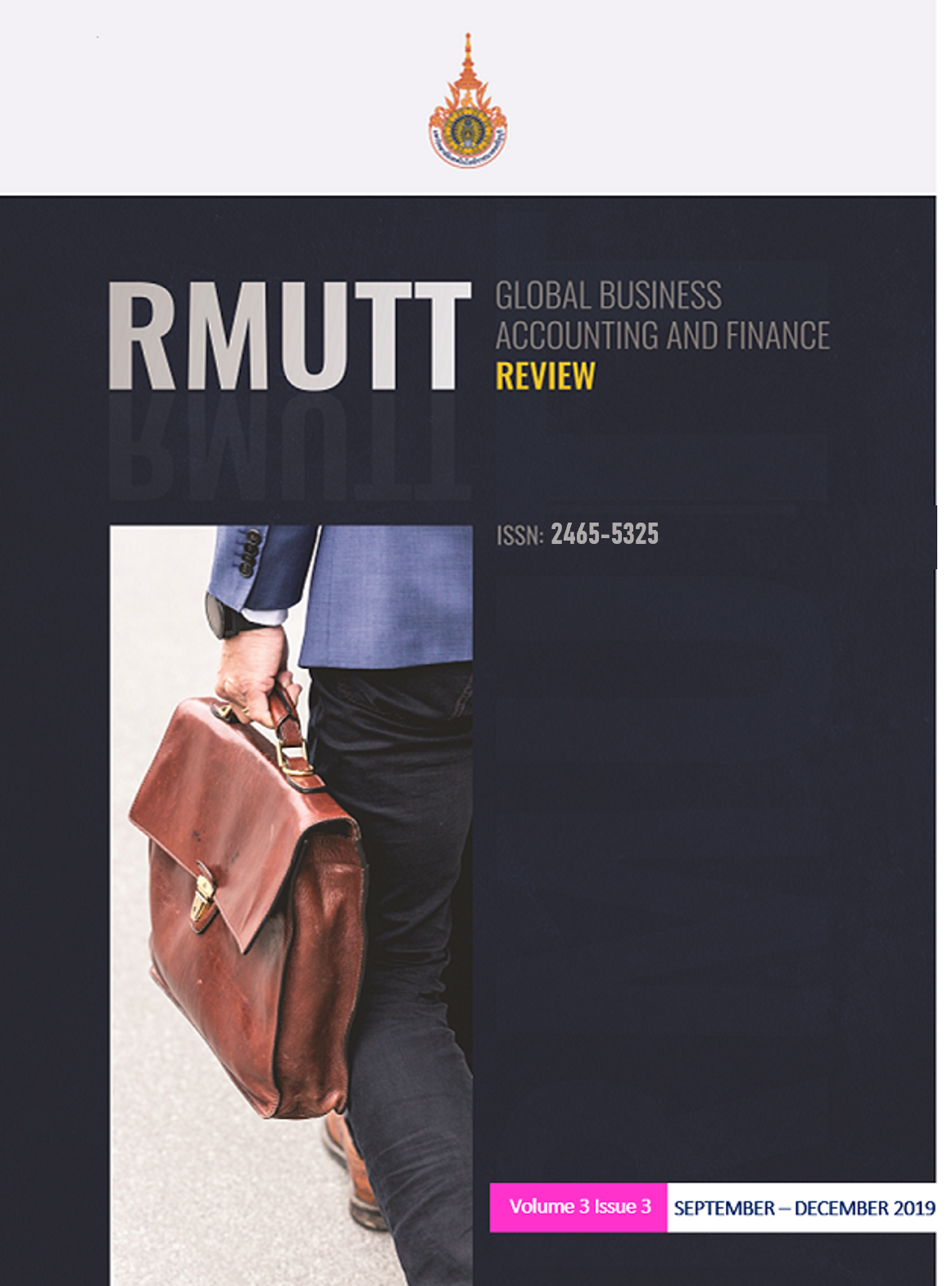DEMOGRAPHICS AND UNDERSTANDING OF STRATEGIC PLANNING CONCERNING THE PERSONNEL INVOLVEMENT IN STRATEGIC PLAN FORMULATION
Keywords:
Demographics, Understanding, Personnel Involvement, Strategic Plan FormulationAbstract
This research is qualitative research aims to study the differences between demographics and personnel involvement as well as the relationship of the understanding & attitude towards personnel involvement, organisational behaviours, and the personnel involvement in the strategic planning process. The samples used in this research are 154 lecturers and employees from the Faculty of Business Administration, Rajamangala University of Technology Thanyaburi. A questionnaire was used as the data collection tool. In particular, the descriptive statistics include frequency, percentage, standard deviation, Pearson correlation were used to analyse the data. The research findings showed that the lecturers and staff from the Faculty of Business Administration, Rajamangala University of Technology Thanyaburi, who possess different demographics in terms of positions, also have different opinions towards the overall involvement in formulating the strategic plan. Whereas employees with different demographics in terms of genders, positions, and types of positions also have different opinions towards personnel involvement in the strategic planning process. Lastly, employees with different demographics in terms of positions also have different opinions regarding participation in the evaluation of the strategic planning process at 0.05 statistical significance level. Besides, the understanding of the strategic planning process in terms of vision formulation, planning, operations, and evaluation was correlated with the personnel involvement in formulating the strategic plan at 0.05 statistical significance level.
References
Best, W. J., & Kahn, V. J. (2006). Research in education (10th ed.). Boston: Pearson.
Boonprasert, A. (1994). Educational Planning. Bangkok: Faculty of Education, Chulalongkorn University.
Chansong, M. (2001). The Level of Knowledge and the Involvement in Forest Conservation of the SAO Members in Chondan District, Phetchaboon Province. (Master‟s thesis, Silpakorn University, Nakorn Pathom Campus).
Chienwattanasook, K., Onputtha, S. & Teppang, T. (2018). Achievement Motive and Organizational Support Perception Affecting Employee‟s Organizational Citizenship: A Case of Bridgestone Group Thailand. Journal of Interdisciplinary Research: Graduate Studies, 7(2), 79-90.
Cohen, M. A. (1988). Some New Evidence on the Seriousness of Crime. Criminology, 26(2), 343-353.
Ford, T. R., & DeJong, G. F. (1970). Social Demography. New Jersey: Prentice Hall.
Golden, M. (2000). A Decade of Demography. Recent Trends in the Study of Greek and Roman Populations. Polis and Politics: Studies in Ancient Greek History: Presented to Mogens Herman Hansen on His Sixtieth Birthday, 23-40.
Hajiar, S. T. (2014). A Statistical Study to Develop a Reliable Scale to Evaluate Instructors within Higher Institution. WSEAS Transactions on Mathematics, 13, 885-894.
Kanpai, R. (2015). The Citizen Involvement in the Tourism Development Plan of Cha-am Municipality, Cha-am Sub-district, Phetchaburi Province. Journal of Humanities and Social Science Review, 6(1), 31-45.
Krejcie, R. V., & Morgan, D. W. (1970). Determining Sample Size for Research Activities. Educational and psychological measurement, 30(3), 607-610.
Kunanuwat, S. (2016). The Citizen Involvement in the Local Development of Bala and Kabang Sub-district Administrative Organisations in Kabang District, Yala Province. Journal of Research and Development, 11(1), 269-279.
Nickols, F. (2000). The Knowledge in Knowledge Management. The Knowledge Management Yearbook, 2000–2001, 12, 21.
Noi-plook, R. (2014). The Citizen Involvement in the Formulation of Local Development Plan for Jae-hom Sub-district, Jae-hom District, Lampang Province. (Master‟s thesis, Graduate College of Nation University).
Nonpati, L. & Rattachattranont, W. (2016). The Citizen Involvement in the Formulation of Local Administrative Organisation‟s Development Plan: The Case study of Wat Lamud Sub-district Administrative Organisation in Nakornchaisri District, Nakorn Pathom Province. Governance Journal, 5(2), 291-305
Policy and Planning Division, Policy and Strategic Planning. (2014). Strategic plan Rajamangala University of Technology Thanyaburi 2018 - 2021. Pathum Thani: Rajamangala University of Technology Thanyaburi
Reeder, W.W. (1974). Some Aspects of the Informal Social Participation of Farm Families in New York State Cornell University. Unpublished Ph.D. Dissertation.
Roopngarm, Y. (2002). The Involvement of the Civil Servants in the Bureau of the Budget for the Bureaucratic System Reformation. (Master Term Paper of Liberal Arts, National Institute of Development Administration).
Siripornwutti., N. (2017). The Citizen Involvement in the Municipality Administration of Phrom Buri Sub-district, Singhaburi Province, in Accordance with the Good Governance Principle. Academic Journal of North Bangkok University, 5(1), 38-45
Siwapaet, S. (2006). General Psychology. Bangkok Metropolitan: Odeon Store.
Sukhothai Thammathirat University. (1997). The Restructuring of the Education System, Unit 7-10. Bangkok: Sukhothai Thammathirat University Publishing.
Vittathanang, J., & Sappa-arsa, R. (2014). The Community Involvement in the Formulation of a 3-year Development Plan of Nadoon Sub-district, Nadoon District, Mahasarakham Province. (Master‟s thesis, Rajabhat Mahasarakham University).
Wongwanich. (2003). Tourism Geography (2nd ed.). Bangkok: Thammasat University.









